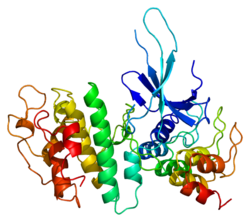Cell cycle
In 1994, Matthew Meyerson and Ed Harlow investigated the product of a close analogous gene of CDK4. [7] This gene, identified as PLSTIRE was translated into a protein that interacted with the cyclins CD1, CD2 and CD3 (same as CDK4), but that was different from CDK4; the protein was then renamed CDK6 for simplicity. [7] In mammalian cells, cell cycle is activated by CDK6 in the early G1 phase [13] through interactions with cyclins D1, D2 and D3. [7] There are many changes in gene expression that are regulated through this enzyme. [14] After the complex is formed, the C-CDK6 enzymatic complex phosphorylates the protein pRb. [15] After its phosphorylation, pRb releases its binding partner E2F, a transcriptional activator, which in turn activates DNA replication. [16] The CDK6 complex ensures a point of switch to commit to division responding to external signals, like mitogens and growth factors. [17]
CDK6 is involved in a positive feedback loop that activates transcription factors through a reaction cascade. [18] Importantly, these C-CDK complexes act as a kinase, phosphorylating and inactivating the protein of Rb and p-Rb related “pocket proteins” p107 and p130. [19] While doing this, the CDK6 in conjunction with CDK4, act as a switch signal that first appears in G1, [7] directing the cell towards S phase of the cell cycle. [14]
CDK6 is important for the control of G1 to S phase transition. [7] However, in recent years, new evidence proved that the presence of CDK6 is not essential for proliferation in every cell type, [20] the cell cycle has a complex circuitry of regulation and the role of CDK6 might be more important in certain cell types than in others, where CDK4 or CDK2 can act as protein kinases compensating its role. [20] [21]
Cellular development
In mutant Knockout mice of CDK6, the hematopoietic function is impaired, regardless of otherwise organism normal development. [20] This might hint additional roles of CDK6 in the development of blood components. [20] There are additional functions of CDK6 not associated with its kinase activity. [22] For example, CDK6 is involved in the differentiation of T cells, acting as an inhibitor of differentiation. [22] Even though CDK6 and CDK4 share 71% amino acid identity, this role in differentiation is unique to CDK6. [22] CDK6 has also been found to be important in the development of other cell lines, for example, CDK6 has a role in the alteration of the morphology of astrocytes [23] and in the development of other stem cells. [10] [16]













